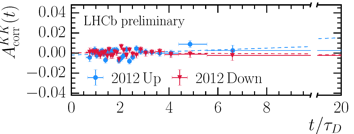The LHCb collaboration presented many new interesting results at the VIIIth International Workshop on Charm Physics (Charm 2016) which took place in Bologna. In particular, precise measurements on the difference between the lifetime of D0 mesons, composed of a cu quark pair, and their partner D0 mesons, with opposite quark content cu (when decaying either to a pair of pions or a pair of kaons) were reported, in order to search for CP-violating effects in the Charm sector.
The phenomenon of CP violation, that is related to the difference between properties of matter and antimatter, is still unobserved in the charm-quark sector. As charm mesons are composed of up-type quarks only, this uniqueness makes the study of their properties particularly relevant. Such properties might be sensitive to effects beyond those predicted by the Standard Model. According to the Standard Model, CP-violating asymmetries in the charm sector are expected to be very small, below the 10-3 level for this measurement. Remarkably, the LHCb experiment is now approaching a level of precision where such small effects could be observed.
Charm mesons are produced either directly in the proton-proton collisions or in the decays of heavier beauty particles. Only the first category was used in this analysis. The difference of the D0 and D0 meson decay rates into K+K– and π+π– pairs was measured as a function of their decay time t. Two distinct measurements were done, which make use of the same data sample but with different experimental approaches. For the K+K–, the asymmetry of the rates is shown in the images. The variation of these quantities depend on the so-called parameter AΓ. The numerical results for AΓ can be found in the LHCb presentation at the workshop as well as in the two conference notes (09) and (10). These are the most precise measurements of CP violation ever made in the Charm sector, and are consistent with no CP violation with a precision of a few parts in 104. Many checks have been done in order to verify the good accuracy of the measurements to such an impressive level of precision. As an example, results obtained with two different orientations of the LHCb magnetic field, “up” and “down”, are compared in the left image above for the data taken in 2012. Note that LHCb presented also other interesting measurements of CP violation at Charm workshop, as well as at the ICHEP conference before, see item (2) of the 5 August 2016 news. Read also the CERN update for the public in English and French.


